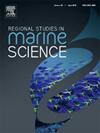Health risk and ecological assessment of potentially toxic elements in seawater along the Betoya Bay coastline, Morocco
IF 2.4
4区 环境科学与生态学
Q3 ECOLOGY
引用次数: 0
Abstract
Betoya Bay, located on the Moroccan coast of the Mediterranean Sea, is a strategically important ecosystem that was significantly impacted by port development, fishing activities, and rapid urbanization. Due to the importance of the Mediterranean Sea in maritime commerce and its increased vulnerability to pollution, the quality of Betoya Bay’s waters is a major international concern. This study examined potentially toxic elements (PTEs) contamination in seawaters of Betoya Bay by collecting samples from five representative sites over the year. PTE concentrations were analyzed, water quality was assessed using ecological indices, and risks to human health were evaluated. The average concentrations (µg/L) were as follows: Zn (166.65) > Pb (24.14) > As (19.71) > Co (8.59) > Cd (3.92) > Cu (3.39) > Cr (0.17) > Ni (<DL). The heavy metal evaluation index (HEI), heavy metal pollution index (HPI), and total potential ecological risk index (PER) showed low contamination, with values ranging from 0.004 to 0.020, 0.030–0.261, and 24.43–104.32, respectively. In contrast, water quality index (WQI) showed low to moderate contamination, with values ranging from 0.48 to 2.44. Human health risk analysis revealed a total hazard quotient (THQ) below 1, indicating negligible non-carcinogenic risk. Additionally, total carcinogenic risk (TCR) values remained below the acceptable threshold (<10−6), confirming tolerable exposure. Statistical analysis revealed multiple sources of pollution, suggesting a combination of anthropogenic and natural inputs. Although the results indicate low contamination and limited health risks for affected populations, it is essential to ensure continuous surveillance of water quality. Persistent anthropogenic inputs and accumulation of PTE in the environment could increase pressure on marine ecosystems and pose long-term risks to human health. Therefore, sustainable management strategies and regular monitoring programs must be implemented to anticipate these developments and preserve the ecological functionality and socioeconomic benefits of Betoya Bay.
摩洛哥贝托亚湾沿岸海水中潜在有毒元素的健康风险和生态评估
贝托亚湾位于摩洛哥地中海沿岸,是一个具有重要战略意义的生态系统,受到港口发展、渔业活动和快速城市化的显著影响。由于地中海在海上贸易中的重要性及其对污染的脆弱性增加,贝托亚湾水域的质量是一个主要的国际关注。本研究在一年的时间里,通过从五个有代表性的地点采集样本,检测了贝托雅湾海水中的潜在有毒元素污染。对PTE浓度进行了分析,利用生态指数对水质进行了评价,并对人类健康风险进行了评价。平均浓度(µg / L)如下:锌(166.65)在 Pb(24.14)在 (19.71)比; 有限公司(8.59)在 Cd(3.92)在 铜(3.39)在 Cr(0.17)在 倪(& lt; DL)。重金属评价指数(HEI)、重金属污染指数(HPI)和总潜在生态风险指数(PER)为低污染,分别为0.004 ~ 0.020、0.030 ~ 0.261和24.43 ~ 104.32。水质指数(WQI)为低至中度污染,范围为0.48 ~ 2.44。人类健康风险分析显示,总危害商(THQ)低于1,表明可忽略不计的非致癌风险。此外,总致癌风险(TCR)值仍低于可接受阈值(<10−6),证实了可耐受的暴露。统计分析揭示了多种污染源,表明人为和自然输入相结合。虽然结果表明受污染程度低,受影响人群的健康风险有限,但必须确保对水质进行持续监测。环境中持续的人为输入和PTE的积累可能会增加对海洋生态系统的压力,并对人类健康构成长期风险。因此,必须实施可持续的管理策略和定期监测计划,以预测这些发展,并保护贝托亚湾的生态功能和社会经济效益。
本文章由计算机程序翻译,如有差异,请以英文原文为准。
求助全文
约1分钟内获得全文
求助全文
来源期刊

Regional Studies in Marine Science
Agricultural and Biological Sciences-Ecology, Evolution, Behavior and Systematics
CiteScore
3.90
自引率
4.80%
发文量
336
审稿时长
69 days
期刊介绍:
REGIONAL STUDIES IN MARINE SCIENCE will publish scientifically sound papers on regional aspects of maritime and marine resources in estuaries, coastal zones, continental shelf, the seas and oceans.
 求助内容:
求助内容: 应助结果提醒方式:
应助结果提醒方式:


